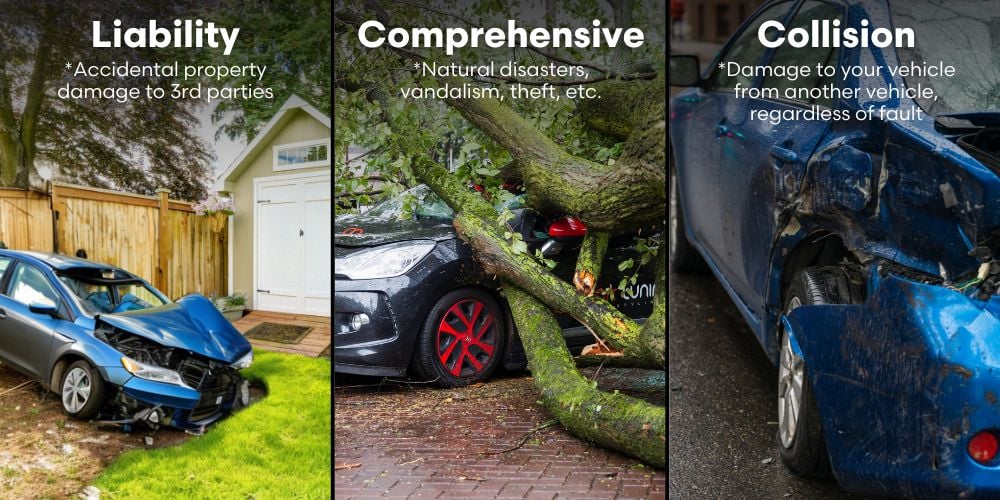Learn the differences between liability, comprehensive, and collision insurance coverage, and why collision insurance may be necessary. Collision coverage is the only type of coverage that financially protects the insured's vehicle in an accident, regardless of who's at fault. Learn when collision coverage is required, such as when financing a vehicle. See the different deductibles available to you and the point at which you should make a claim on your insurance.
How is Collision Coverage Different from Liability and Comprehensive?
Liability coverage only covers damages to other people's property and/or injuries. Comprehensive covers damage to your car that was not caused by another car, (natural disaster, animal collision, theft, fire, etc.). Collision insurance covers the damage to your vehicle in a collision, as the name would indicate. This includes but is not limited to:
- At-fault collisions with other vehicles
- Collisions with property (fences, lamp posts, etc.)
- Collisions with inanimate objects on the roadway (deceased animals, furniture, appliances, etc.)
- Hit and runs

While this type of insurance is the most costly, it is the only coverage that financially protects your vehicle in an accident, regardless of who is at fault. You’re not required to carry collision coverage on your vehicle unless it is financed.
Collision Coverage for Financed Vehicles
If you purchase a new vehicle and are financing that vehicle through the dealership or a bank you are required to have full collision coverage on the vehicle. In the event of a total loss to the vehicle, the financer is still going to want to be repaid the loan.
Before purchasing a new vehicle, it’s always a good idea to talk to your insurance broker. It’s one thing to be able to afford the $600/month car payment, but if your insurance is going to go through the roof on a financed vehicle, then you might want to reconsider your purchase. If you have already purchased a financed vehicle and are looking to get auto insurance, you’ll need your bill of sale and financing information handy.

Collisions with Inanimate Objects
While uncommon, collisions with inanimate objects do happen. Things that you wouldn't normally expect to see on the road can occasionally end up on the road for one reason or another. Whether it be couches, washing machines, mattresses, suitcases, or some other inanimate object, if you accidentally hit it, it could result in serious damages to your vehicle.
Most drivers don't know that if you hit an inanimate object, only collision insurance would protect you financially. If you only have comprehensive coverage on a vehicle and you hit an errant sofa on highway 2, you're going to be responsible for all of the damages to your vehicle.

Coverage For Hit and Runs
One of the most significant benefits of collision coverage is its protection against hit-and-run accidents. If you're involved in an accident where the other driver flees the scene (this also applies to collisions where your vehicle is parked), collision coverage can help pay for the damages to your car. When one of our staff members had their car mirrors broken, only collision coverage would have had protection.
If you park your vehicle on the street rather than in a garage or driveway, you may want to consider collision coverage. According to City of Edmonton Police Services, on average, there are 30 hit and run reports in Edmonton every day. That equates to around 11,000 hit and runs every year in the Edmonton area alone. Collision insurance can help cover the damages in a hit and run.
What About Deductibles?
Deductibles are the base amount of money you need to pay out before insurance coverage kicks in. Your deductible needs to be paid out at each claim. If you have multiple claims in a year, you’ll need to pay your deductible every time. Depending on the company, your deductible can range from as low as $250 all the way up to $25,000. Most collision deductibles are between $500-$2,500.
Typically, the higher the deductible, the lower your monthly premium. With that being said, the difference between a $1,000 deductible and a $25,000 deductible is usually an insignificant difference on your monthly payments ($10-$20/month difference). It’s important to ensure you have a deductible that you can afford and that makes sense for your vehicles value. Carrying a $25,000 deductible on a vehicle that is only worth $20,000 would not be a very wise decision.
In some cases, insurers will require you to have a minimum deductible of $2,500. This can occur if you have:
- You have 3 or more tickets in the previous 3 years
- You have 2 or more accidents in the previous 6 years
Additionally, if you have a high value vehicle (over $100,000) insurers may require an even higher deductible. This usually starts at $5,000 and can reach $10,000 or more.

When Should I Make a Collision Claim?
If your vehicle has suffered damages that wouldn't fall under comprehensive insurance coverage, you might be wondering when it's worth it to make a claim on your insurance. As a baseline, if the damages are going to cost less than your deductible, it's not worth making a claim.
It's also important to consider what making a claim will do to your insurance premiums. A single at fault claim can increase your premiums by 10%-55%, depending on your premiums and driving record. If you have an accident forgiveness endorsement on your auto insurance policy, this is less likely to be a factor.
In order to get a better idea of when to make a collision claim, here are four real life scenarios and what the motorist decided to do.
- Broken Car Mirror
- Cracked Bumper
- Scratched and Dented Roof
- Rear Ended
Broken Car Mirror
One of our staff members had their passenger car mirror smashed in a hit and run. They had a $1,000 deductible on their insurance for collision claims. After having done a little research and getting costs estimates, it was only going to cost around $150 to replace the mirror themselves without a considerable effort. In this case, it wasn't worth going through insurance.
If the mirror had been on an expensive imported vehicle and was going to cost $3,800 to replace, it may have been worthwhile to contact your broker.
Cracked Bumper
In this scenario, the driver was living in an older building that didn't have great drainage in the parking lot. Overnight, what was once a deep puddle turned into large mounds of ice in the parking lot. While it was still dark, the driver went to exit the parking lot and did not see the ice that had formed. They struck the ice and cracked the bottom half of their bumper clean off. They contacted the condo board and were told that they wouldn't provide any compensation for the damages.
This person also had a $1,000 deductible for collision on their policy. After running the estimates on the vehicle, this person decided they would be better off paying for the repairs out of pocket. The damage was superficial and didn't need to be repaired immediately. Since the vehicle was a popular and mass produced vehicle, they were able to source a used bumper from a local vendor and have it installed for less $600.
Scratched and Dented Roof
This scenario is a little different in that vehicle in question was a much higher value vehicle. While the 2 previous examples had been vehicles that were between 7-10 years old, this vehicles was only 3 years old and was purchased new from the dealership.
This driver was driving their truck in an underground parkade and they did not realize that their vehicle was taller than the maximum. They quickly realized the error of their ways when they heard the disparaging noise of the roof of the truck scraping against the concrete roof of the parking structure.
This driver got out of the parking structure and started assessing the damages. Thick scrapes and dents going right down to the bare metal on the roof of the truck. After getting an estimate done at the body shop, the damages were going to total around $1,500. After doing some quick math, the driver knew that after they paid their $1,000 deductible, there wouldn't be much of the repair left to pay. At this amount, the driver opted to just pay out of pocket.
Rear End Hit and Run
In this final scenario, the vehicle in question was a five year old Japanese sedan with a $1,000 deductible on the insurance. The driver was transporting their young child in the back seat to their next destination when they were rear ended by a driver. The driver that hit them panicked and took off. Thankfully, both the driver and child passenger were completely unharmed.
This particular vehicle was designed with a large crumple zone in the trunk of the vehicle. Crumple zones are designed to take the force of a collision and crumple the vehicle, which makes them considerably safer for passengers. Unfortunately, crumple zones also create significantly more expensive repairs.
In this case, the vehicle had nearly $7,000 in damages to the rear end. Naturally, the driver made the decision to go through their insurance. All the driver had to pay was the $1,000 deductible.
So, When Should you Make a Collision Claim?
A good rule of thumb is to make a claim on your insurance when the repair/replacement cost is going to be at least $1,250 higher than your deductible. If you have a $1,000 deductible, making a claim at $2,250 and up is fairly common practice. That being said, it's a decision that will be different for every individual. If you're not sure if you should make a claim, you can always talk to your broker first, they are there to help you.
Conclusion
In conclusion, collision coverage can be a crucial component of auto insurance. It can help protect you in the event of an accident, even if it's a hit-and-run. It's important to consider your deductible and understand what it does and doesn't cover.
Need help navigating the insurance market? We're here to help. Our team of experts can help you get the best coverages for a price that work for you.
or







